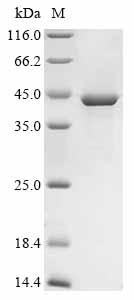Recombinant Mouse Tsukushi (Tsku)
CAT:
399-CSB-EP025140MO-01
Size:
1 mg
Price:
Ask
- Availability: 24/48H Stock Items & 2 to 6 Weeks non Stock Items.
- Dry Ice Shipment: No




Recombinant Mouse Tsukushi (Tsku)
- CAS Number: 9000-83-3
- Gene Name: Tsku
- UniProt: Q8CBR6
- Expression Region: 18-354aa
- Organism: Mus musculus
- Target Sequence: TRPCFPGCQCEEETFGLFDSFSLIRVDCSSLGPHIVPVPIPLDTAHLDLSSNRLETVNESVLAGPGYTTLAGLDLSYNLLTSIMPSAFSRLRYLESLDLSHNGLAALPAEIFTSSPLSDINLSHNRLREVSISAFTTHSQGRALHVDLSHNLIHRLLPHPARASLPAPTIQSLNLSWNRFRAVPDLRDLPLRYLSLDGNPLATINPDAFMGLAGLTHLSLASLQGILHLPPHGFRELPGLQVLDLSGNPKLKWAGAEVFSGLGLLQELDLSGSSLVPLPEMLLHHLPALQSVSVGQDVQCRRLVREGAYHRQPGSSPKVVLHCGDTQESAARGPDIL
- Tag: N-terminal 10xHis-tagged and C-terminal Myc-tagged
- Source: E.coli
- Field of Research: Others
- Assay Type: In Stock Protein
- Relevance: Contributes to various developmental events and other processes such as wound healing and cholesterol homeostasis through its interactions with multiple signaling pathways. Wnt signaling inhibitor which competes with WNT2B for binding to Wnt receptor FZD4 and represses WNT2B-dependent development of the peripheral eye. Plays a role in regulating the hair cycle by controlling TGFB1 signaling. Required for the development of the anterior commissure in the brain by inhibiting neurite outgrowth. Essential for terminal differentiation of hippocampal neural stem cells. Plays a role in regulating bone elongation and bone mass by modulating growth plate chondrocyte function and overall body size. Required for development of the inner ear through its involvement in stereocilia formation in inner hair cells. Facilitates wound healing by inhibiting secretion of TGFB1 from macrophages which prevents myofibroblast differentiation, maintaining inflammatory cell quiescence. Plays a role in cholesterol homeostasis by reducing circulating high-density lipoprotein cholesterol, lowering cholesterol efflux capacity and decreasing cholesterol-to-bile acid conversion in the liver. In one study, shown to negatively regulate sympathetic innervation in brown fat, leading to reduced energy expenditure. In another study, shown not to affect brown fat thermogenic capacity, body weight gain or glucose homeostasis.
- Purity: Greater than 90% as determined by SDS-PAGE.
- Activity: Not Test
- Length: Full Length of Mature Protein
- Form: Liquid or Lyophilized powder
- Buffer: If the delivery form is liquid, the default storage buffer is Tris/PBS-based buffer, 5%-50% glycerol. If the delivery form is lyophilized powder, the buffer before lyophilization is Tris/PBS-based buffer, 6% Trehalose, pH 8.0.
- Reconstitution: We recommend that this vial be briefly centrifuged prior to opening to bring the contents to the bottom. Please reconstitute protein in deionized sterile water to a concentration of 0.1-1.0 mg/mL.We recommend to add 5-50% of glycerol (final concentration) and aliquot for long-term storage at -20℃/-80℃. Our default final concentration of glycerol is 50%. Customers could use it as reference.
- Molecular Weight: 44.0 kDa
- References & Citations: "Loss of Tsukushi causes the retinal degradation." Kuriyama S., Ohta K., Sawai H., Takahashi M., Tanaka H. Submitted (MAY-2005)
- Storage Conditions: The shelf life is related to many factors, storage state, buffer ingredients, storage temperature and the stability of the protein itself. Generally, the shelf life of liquid form is 6 months at -20℃/-80℃. The shelf life of lyophilized form is 12 months at -20℃/-80℃.
